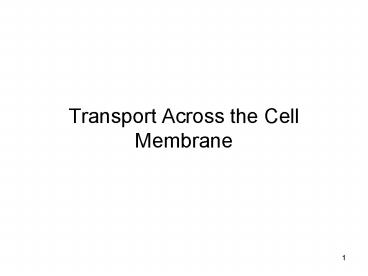Transport Across the Cell Membrane - PowerPoint PPT Presentation
1 / 16
Title:
Transport Across the Cell Membrane
Description:
Transport Across the Cell Membrane * * ALL cells possess a cell membrane (mb)(~8 nm thick). Membranes function to control the passage of materials into/out of the ... – PowerPoint PPT presentation
Number of Views:48
Avg rating:3.0/5.0
Title: Transport Across the Cell Membrane
1
Transport Across the Cell Membrane
2
- ALL cells possess a cell membrane (mb)(8 nm
thick). - Membranes function to control the passage of
materials into/out of the cell (act like
gatekeepers). - Membranes are described as being selectively
permeable. - -- a mb that is completely permeable will allow
anything and everything to pass through it. - -- a mb that is impermeable will allow nothing
to pass through it. - Therefore, a selectively permeable membrane will
only allow certain molecules across. - The selection criteria may be based on size,
polarity, ATP (energy) availability or a
combination of any of these factors.
3
IMPERMEABLE OIL SLICKERS
COMPLETELY PERMEABLE
MAPLE LEAFS GOALTENDING
4
- Other mb functions include
- -- separating the cytoplasm from the
Extracellular Fluid (ECF), in other words,
housing the organelles. - -- communication with other cells.
- -- identifying the cell.
5
General Structure and Function of the Cell
Membrane
- The primary structure of all membranes is a
PHOSPHOLIPID BILAYER with proteins embedded
either partially (peripheral proteins more for
support purposes) or completely through it
(integral proteins). - The anchoring of integral proteins is discussed
later peripheral proteins occur either on the
outside or inside of the mb anchored either by
covalent bonds, or by weaker, intermolecular
interactions. - Carbohydrates are evident as well, associating
with either the phospholipids (forming
glycolipids) or with the proteins (forming
glycoproteins). These carbs only associate on
the outer edge of the mb. more later - Cytoskeletal filaments associate with the inner
portion of the mb in order to anchor it.
6
Fluid-Mosaic Model of a Cell Membrane (fig 4.1
p.68)
- Phospholipids serve as the grout or fluid
portion of the membrane (membranes possess the
consistency of a light olive oil ie. The grout
does not harden, or else long nerve cells would
crack as you moved!). - Proteins/glycoproteins serve as the mosaic, but
can (and do) move around within the fluid bilayer
(like wading through a pool of oil). See fig. 4.2
p. 69 - Cholesterol is also present in the cell mb and
serves to lend stability to the phospholipid
bilayer when the temperature rises.
7
- Conversely, cholesterol prevents a decrease in mb
fluidity when temperatures decrease. - Ie. Cholesterol does not let the cell mb become
too fluid at higher temperatures and also does
not let the mb become too rigid at lower
temperatures. - A structural buffer???
- As well, cholesterol acts as a physical barrier
in the mb, disallowing larger molecules from
crossing on their own. - Glycolipids and Glycoproteins serve as
identifiers and communicators for the cell (ie. A
drivers licence or fingerprint).
8
Fluid-Mosaic Model Picture
9
Phospholipid Bilayer Structure
- Each phospholipid molecule in the mb has a POLAR
(charged or hydrophilic) head and two NON-POLAR
(uncharged or hydrophobic) tails (see fig. 2.27
p.35). - Hydro-philic Water-loving
- Hydro-phobic Water-hating
- Phospholipid molecules are referred to as being
amphipathic in that they are part polar, and part
non-polar.
10
- Cells are surrounded by water (ECF) and are
filled with water (cytoplasm), so the heads face
outward and inward. - The non-polar tails bury (hide) together to stay
as much away from water as they can (hence, the
double layer). - Very little water (if any) in between the layers.
- This bilayer arrangement is spontaneous (requires
no energy)
11
- Another simple diagram
- Micelles form when a handful of phospholipid
molecules are placed in water. - Micelles are made artificially.
ECF
CYTO.
Very little water
12
- Hydrogen bonds between the polar heads of the
phospholipids and water on either side of the mb
help to keep the bilayer intact. - So do the hydrophobic interactions (London
Forces) that exist between the tails of the
phospholipids. - Phospholipids are able to move or shift in the
bilayer since the individual molecules are not
bound to each other. However, they can only
shift in one layer, they very rarely flip over
to the opposite layer. Why not?
13
Transporting of Substances Across Mb
- Due to the highly hydrophobic (non-polar) inner
core of the phospholipid bilayer, only certain
molecules/substances are able to move in/out of a
cell without aid of some kind. - What, therefore, is able to move across a mb on
its own? - Water! Follows a concentration gradient (moves
from higher to lower water concentrations (ie.
lower to higher solute concentrations))the
diffusion of water is known as osmosis. In
general, the strength of the flow (bulk flow)
of water pushes it through the hydrophobic core
undeterred. - Small, non-polar molecules
- -- relatively small hydrocarbons.
- -- oxygen (O2)
- -- carbon dioxide (CO2)
- One larger, non-polar molecule-type ? fatty
acids. - These molecules simply diffuse across the
phospholipid bilayer.
14
- What molecules/substances CANNOT move across a mb
on its own (and why not)? - -- Ions/salts (Na, K, Ca2, Cl-, etc.)
these are charged, and therefore polar ions
requiring channel/carrier proteins (more on these
later). As well, they tend to be surrounded by
water molecules, making them seem bigger than
they really are, allowing the hydrophobic core of
the mb to repel them more easily. - -- Larger polar molecules (glucose, amino
acids, glycerol etc) require carrier proteins
as they are too large for channel proteins. - -- Macromolecules (Carbohydrates, Proteins,
Fats) they are simply too big, but can enter
through vesicle formation (endocytosis) or exit
through vesicle formation (exocytosis) (more on
these later too). - - SEE FIG. 4.4 p. 72
15
(No Transcript)
16
(No Transcript)































